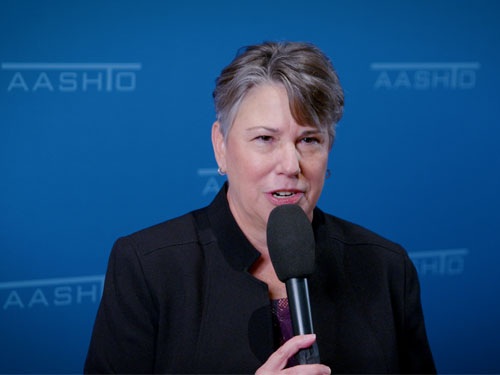Dr. Shawn Wilson (seated above at far right) and Russell McMurry (seated in the middle) recently shared the perspectives of the state department of transportation community regarding the use of public-private partnerships or “P3s” for major infrastructure projects.
[Above image by AASHTO]
Wilson is the secretary for the Louisiana Department of Transportation and Development as serves as the American Association of State Highway and Transportation Officials 2021-2022 president. McMurry is the commissioner of the Georgia Department of Transportation and AASHTO’s treasurer.
Both spoke at the American Road & Transportation Builders Association 34th annual “P3s in Transportation” conference held in Washington, D.C., July 13-15.

When it comes to P3s, Wilson said it is critical to place such projects into the broader context of what’s going on in the transportation sector – especially in terms of the economic and workforce trends facing the industry and state DOTs in particular right now, such as inflation.
“The most looming impact of inflation for state DOTs is that it is cutting into 30 percent to 40 percent of what we are doing,” he explained. “In terms of the global supply chain, materials are becoming harder to pay for and even harder to get.”
He added that workforce issues are becoming more significant as well as state DOTs are struggling to keep people employed and hire people, as well. “And when we seek to hire for a position yet get zero applicants, that is both alarming and a major challenge,” Wilson said.

States not only have to deliver projects on time in this environment, they must deal with increase in expenditures to get them delivered as well, Wilson said – and that is one area where the P3 structure can help.
“For states, we have projects and programs we’ve been working and building towards for many years,” he explained. “When it comes to making a decision on what to fund, we need to look at the source and rules around that funding. That is one challenge P3s have to go through, but they end up making more sense if they lower the cost of procurement.”
McMurry noted that every P3 project and state environment in regards to using P3s is unique. “That means they [P3s] require a real ‘grass roots’ support effort so politics does not become a barrier to a project,” he said.

“The flip side is that grassroots support can be a big help. It means you must understand your ‘social map’ in terms of who your supporters and detractors are,” McMurry noted. “That means you must really listen to and understand public perception of a project: you need to put in the upfront work in educating both the public and your legislators. It is a lot of work behind the scenes to manage expectations.”
That “education” is critical for the length of time for most P3 projects is well beyond the political terms of local and state legislators, as well as for governors. “Change in leadership always poses a risk – it’s something you must think about,” he pointed out.
“While politics and policy are two different things, one drives the other – politics is what drives the policy. So it is incumbent on us to continually educate the public and our legislators about the value of the project,” he said. “All politics are local and they inform state and federal politics. And you need that alignment, because you must have that alignment to move things ahead.”

Wilson agreed with McMurry’s perspective, yet emphasized that the P3 support issued goes “deeper than politics” and entails creating an “understanding” about how infrastructure projects are done.
“It’s all about how a project provides real value for our constituents,” he said. “That is what can or cannot move the politics on a project.”
Wilson added that state DOTs “do not have luxury of taking an opinion” on any particular project as “we are bound by facts, data processes, and precedent.” That is why being able to accommodate change is so critical, especially where P3 projects are concerned, he stressed.
“Cost is greatest hurdle in the public sector,” Wilson noted. “That is why we must continually explain to the community why we are spending money – we need to build that into the P3 model and selection process so we continually address that issue.”
 Top Stories
Top Stories
USDOT Makes $1.5B Worth of BUILD Grants Available
December 19, 2025 Top Stories
Top Stories

